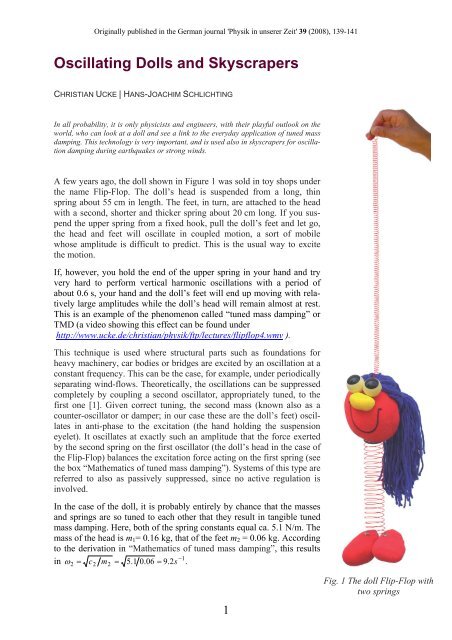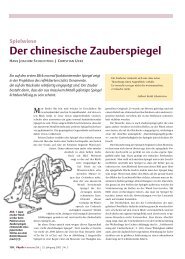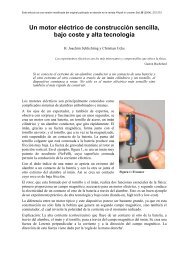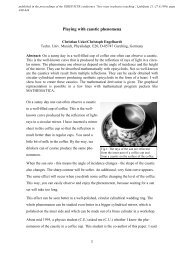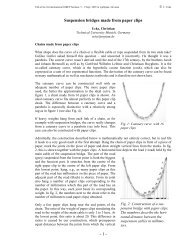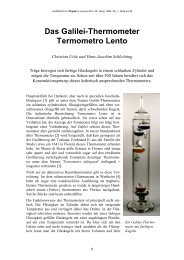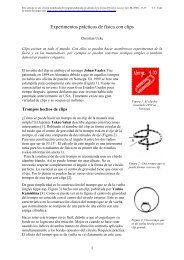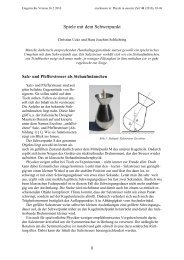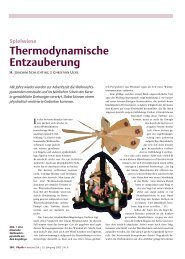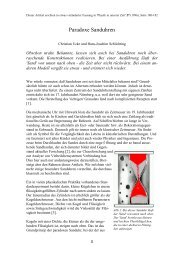Oscillating Dolls and Skyscrapers
Oscillating Dolls and Skyscrapers
Oscillating Dolls and Skyscrapers
You also want an ePaper? Increase the reach of your titles
YUMPU automatically turns print PDFs into web optimized ePapers that Google loves.
Originally published in the German journal 'Physik in unserer Zeit' 39 (2008), 139-141<br />
<strong>Oscillating</strong> <strong>Dolls</strong> <strong>and</strong> <strong>Skyscrapers</strong><br />
CHRISTIAN UCKE | HANS-JOACHIM SCHLICHTING<br />
In all probability, it is only physicists <strong>and</strong> engineers, with their playful outlook on the<br />
world, who can look at a doll <strong>and</strong> see a link to the everyday application of tuned mass<br />
damping. This technology is very important, <strong>and</strong> is used also in skyscrapers for oscillation<br />
damping during earthquakes or strong winds.<br />
A few years ago, the doll shown in Figure 1 was sold in toy shops under<br />
the name Flip-Flop. The doll’s head is suspended from a long, thin<br />
spring about 55 cm in length. The feet, in turn, are attached to the head<br />
with a second, shorter <strong>and</strong> thicker spring about 20 cm long. If you suspend<br />
the upper spring from a fixed hook, pull the doll’s feet <strong>and</strong> let go,<br />
the head <strong>and</strong> feet will oscillate in coupled motion, a sort of mobile<br />
whose amplitude is difficult to predict. This is the usual way to excite<br />
the motion.<br />
If, however, you hold the end of the upper spring in your h<strong>and</strong> <strong>and</strong> try<br />
very hard to perform vertical harmonic oscillations with a period of<br />
about 0.6 s, your h<strong>and</strong> <strong>and</strong> the doll’s feet will end up moving with relatively<br />
large amplitudes while the doll’s head will remain almost at rest.<br />
This is an example of the phenomenon called “tuned mass damping” or<br />
TMD (a video showing this effect can be found under<br />
http://www.ucke.de/christian/physik/ftp/lectures/flipflop4.wmv ).<br />
This technique is used where structural parts such as foundations for<br />
heavy machinery, car bodies or bridges are excited by an oscillation at a<br />
constant frequency. This can be the case, for example, under periodically<br />
separating wind-flows. Theoretically, the oscillations can be suppressed<br />
completely by coupling a second oscillator, appropriately tuned, to the<br />
first one [1]. Given correct tuning, the second mass (known also as a<br />
counter-oscillator or damper; in our case these are the doll’s feet) oscillates<br />
in anti-phase to the excitation (the h<strong>and</strong> holding the suspension<br />
eyelet). It oscillates at exactly such an amplitude that the force exerted<br />
by the second spring on the first oscillator (the doll’s head in the case of<br />
the Flip-Flop) balances the excitation force acting on the first spring (see<br />
the box “Mathematics of tuned mass damping”). Systems of this type are<br />
referred to also as passively suppressed, since no active regulation is<br />
involved.<br />
In the case of the doll, it is probably entirely by chance that the masses<br />
<strong>and</strong> springs are so tuned to each other that they result in tangible tuned<br />
mass damping. Here, both of the spring constants equal ca. 5.1 N/m. The<br />
mass of the head is m 1 = 0.16 kg, that of the feet m 2 = 0.06 kg. According<br />
to the derivation in “Mathematics of tuned mass damping”, this results<br />
−1<br />
in ω = c m = 5.1 0.06 = 9.2s<br />
.<br />
2<br />
2<br />
2<br />
1<br />
Fig. 1 The doll Flip-Flop with<br />
two springs
Originally published in the German journal 'Physik in unserer Zeit' 39 (2008), 139-141<br />
The oscillation period calculated from the above is T = 0.68 s, which agrees roughly with the<br />
measured period. In this case, moreover, given that c 1 = c 2 , equation (5) in “Mathematics of<br />
tuned mass damping” leads to X 2 = –X e . This means that the doll’s feet oscillate with the<br />
same amplitude as the excitation, albeit exactly in anti-phase. A more exact analysis of this<br />
example would make little sense here, since the doll’s parameters are not – <strong>and</strong> cannot be –<br />
precisely adjusted. In addition, this is an atypical case since the ratio of the tuned mass (feet)<br />
to the main system (head) is relatively large.<br />
A somewhat more<br />
detailed consideration<br />
of a system<br />
damped with<br />
springs leads to<br />
the following: if<br />
the suspension<br />
point of a spring<br />
from which a<br />
mass is hanging is<br />
deflected harmonically,<br />
we get<br />
the resonance<br />
curve shown in<br />
Figure 2. Here the<br />
black curve represents<br />
the amplitude<br />
of the main<br />
Fig. 2 Oscillation of a system without <strong>and</strong> with damper:<br />
system as a function<br />
of the ratio<br />
f 0 is the resonant frequency of the main system without damper,<br />
f the frequency of the main system without (black) <strong>and</strong> with damper<br />
between the exciting<br />
frequency f<br />
(red).<br />
<strong>and</strong> the natural<br />
frequency f 0 of this system.<br />
If we add to the main system a damper with springs <strong>and</strong> damping, then given a suitable choice<br />
of parameters the original maximum amplitude (resonance) can be reduced drastically (suppressed).<br />
The natural frequency of the damper mass with its damping spring is set to the frequency<br />
that needs to be eliminated. If necessary, the damper can exhibit large amplitudes with<br />
considerable forces at the spring’s attachment point to the main system. At this frequency, it<br />
extracts oscillation energy from the main system.<br />
This has to be paid for, however, in the form of two new natural frequencies with smaller amplitudes<br />
above <strong>and</strong> below the damper’s natural frequency (red curve in Figure 2). They arise<br />
from the combination of the main system with the damper, namely from the same-phase <strong>and</strong><br />
anti-phase oscillation of the main system with damper. At these frequencies, the main system<br />
must necessarily undergo amplified oscillations.<br />
The oscillation curve can be affected considerably by varying the damping parameters. We<br />
have considered initially only the simplest case of a single-frequency, harmonic excitation.<br />
Things tend to be considerably more complex in the real world, such that elaborate measurements<br />
<strong>and</strong> calculations are necessary in order to select the appropriate damper parameters.<br />
2
Originally published in the German journal 'Physik in unserer Zeit' 39 (2008), 139-141<br />
Tuned mass dampers in buildings<br />
It is a fairly large step from toys to buildings. The Millennium Bridge in London, designed by<br />
the celebrated architect Sir Norman Foster, is a well-known example of an oscillating bridge.<br />
At the bridge’s opening ceremony in the year 2000, up to 2000 people walked across it together.<br />
While doing so, they fell unconsciously into a nearly synchronised walk <strong>and</strong> the<br />
bridge started oscillating, both vertically <strong>and</strong> horizontally, at a frequency just under 1 Hz. At<br />
no time was there any danger of the bridge collapsing: at worst, some of the pedestrians felt<br />
nauseous. The bridge was then closed.<br />
The underlying reason for this effect was inadequate construction. The phenomenon of resonance<br />
excitation, which may even end in resonance catastrophe, is known from the crossing<br />
of bridges by soldiers marching in step. The German specialist firm of Gerb managed to stabilise<br />
the Millennium Bridge by adding tuned mass dampers in both the vertical <strong>and</strong> the horizontal<br />
direction. Now, up to 3000 people can cross the bridge in marching formation without<br />
any risk [2].<br />
Another famous example, one that<br />
can be viewed on site, is the skyscraper<br />
Taipei 101 in Taiwan,<br />
completed in 2003, where 101<br />
denotes the number of floors. Its<br />
height including aerials is 509 m,<br />
the roof without aerials terminates<br />
at 448 m. This building contains<br />
not one but three tuned mass<br />
dampers, which damp oscillations<br />
generated by earthquakes <strong>and</strong><br />
winds. The largest tuned mass is a<br />
sphere with a diameter of about<br />
5.5 m, assembled from steel plates<br />
(Figure 3). It has a mass of 662<br />
tonnes, <strong>and</strong> is suspended from steel<br />
cables 42 m long that reach from<br />
the 92 nd to the 88 th floor (Figure 4).<br />
Currently, this is the world’s largest<br />
tuned mass damper.<br />
Fig. 3 Tuned mass damper pendulum at Taipei 101.<br />
The building oscillates occasionally up to 35 cm either way. During super-typhoons, which<br />
are expected on average only once every hundred years but are becoming ever more frequent,<br />
even amplitudes of 150 cm are conceivable. The damper pendulum damps the oscillations by<br />
up to 40%. Equation (7) predicts an oscillation period of around 13 s.<br />
The oscillation period of the first natural frequency of high buildings can be estimated very<br />
roughly by using the following formula, quoted in DIN 1055-4 [3]: T 1 = H/46 (where T is in<br />
seconds <strong>and</strong> H in metres). The relevant height of the structure is the one measured to the upper<br />
edge of the rigid supporting structure; superstructures <strong>and</strong> aerials are ignored. For Taipei<br />
101, the resulting period of T 1 = 9.7 s agrees reasonably well with the figure quoted above,<br />
bearing in mind the rough estimates used.<br />
3
Originally published in the German journal 'Physik in unserer Zeit' 39 (2008), 139-141<br />
Deflections of s = 35 cm<br />
result in horizontal<br />
accelerations of around<br />
a = ω 2·s ≈ 0.2 ms –2 , which<br />
is about 1/50 of the earth’s<br />
gravitational acceleration.<br />
This is easily tolerated by<br />
most people when exposed<br />
to it for a short time.<br />
Longer exposures can<br />
cause nausea. Presumably,<br />
the top floor is not exactly<br />
overcrowded during<br />
storms.<br />
In Germany, the Berlin<br />
television tower (Figure 5)<br />
built during the DDR era is<br />
provided with a 1.5 t<br />
damper pendulum suspended<br />
in the tower’s tip.<br />
The total height of the<br />
tower to the tip of the aerial<br />
is 368 m, with the concrete<br />
shaft reaching a height of<br />
250 m. Oscillation periods<br />
of 7 to 10 s are stated. Using<br />
the approximation formula<br />
gives T 1 = 5.4 s.<br />
Fig. 4 The Taipei 101 skyscraper with the tuned mass damper<br />
shown to scale.<br />
Fig. 5 Berlin television tower.<br />
At the café’s altitude<br />
(208 m), the amplitudes under average wind intensities are around 15 cm, at the aerial’s tip up<br />
to 60 cm. Assuming T = 7 s, the accelerations (ca. 0.1 ms –2 ) are hardly even noticeable. The<br />
level of the coffee in a visitor’s cup varies only imperceptibly under such conditions.<br />
Bibliography<br />
[1] K. Magnus, K. Popp, Schwingungen [Oscillations], B.G. Teubner Publ., Stuttgart 2005.<br />
[2] H. Bachmann, Lebendige Fußgängerbrücken - eine Herausforderung [Living pedestrian<br />
bridges – a challenge], Bautechnik [Structural Engineering] 2004, 227.<br />
[3] DIN 1055-4, Einwirkungen auf Bauwerke, Teil 4: Windlasten [Effects on structures, Part<br />
4: Wind loads], 2005.<br />
Addresses<br />
Dr. Christian Ucke, 14B Rofanstrasse, 81825 Munich.<br />
ucke@mytum.de<br />
Prof. Dr. Hans-Joachim Schlichting, Physics teaching, Muenster<br />
University, 48149 Muenster.<br />
schlichting@uni-muenster.de.<br />
4
Originally published in the German journal 'Physik in unserer Zeit' 39 (2008), 139-141<br />
MATHEMATICS OF TUNED MASS DAMPING<br />
Schematic description of<br />
a tuned mass damper.<br />
The illustration above shows a system consisting of two springs <strong>and</strong> two masses. Let the suspension<br />
point move harmonically up <strong>and</strong> down with an amplitude X e <strong>and</strong> frequency ω e . This can be written as:<br />
(1) x = X cosω<br />
t<br />
e<br />
e<br />
e<br />
Without damping effects, Newton’s Second Law leads immediately to the following equations:<br />
(2) m & x<br />
= ΣF<br />
= −c<br />
x − xe ) − c ( x − )<br />
1 1 1 1( 1<br />
2 1<br />
x2<br />
(3) m & x<br />
= ΣF<br />
= −c<br />
x − )<br />
2 2 2 2<br />
(<br />
2<br />
x1<br />
Using the abbreviations<br />
c + c<br />
c<br />
1 2 2 2 2 2<br />
1 2<br />
= ω<br />
1<br />
= ω2<br />
= μ = ω 0<br />
m1<br />
m2<br />
m1<br />
m1<br />
we get the solution<br />
2 2 2<br />
ω0<br />
( ω2<br />
− ωe<br />
) X<br />
e<br />
(4) x1<br />
= X<br />
1<br />
cosωet<br />
=<br />
cosωet<br />
2 2 2 2 4<br />
( ω − ω )( ω − ω ) − μω<br />
2 2<br />
X<br />
(5) x X cos ω0ω2<br />
e<br />
2<br />
=<br />
2<br />
ωet<br />
=<br />
cosωet<br />
2 2 2 2<br />
( ω − ω )( ω − ω ) − μω<br />
4<br />
1<br />
1<br />
e<br />
e<br />
2<br />
2<br />
e<br />
e<br />
The masses m 1 <strong>and</strong> m 2 oscillate at the same frequency ω e as the exciting oscillation. The amplitudes are<br />
derived from equations (4) <strong>and</strong> (5). The amplitude X 1 of mass m 1 equals zero when<br />
(6) ω<br />
e<br />
= ω2 = c2<br />
m2<br />
.<br />
In general, this condition can be met by varying c 2 <strong>and</strong>/or m 2 .<br />
It should be noted that this calculation holds strictly for one particular frequency only, <strong>and</strong> assuming no<br />
further damping effects. This does not happen in the real world.<br />
The construction illustrated in Figure 7 is realised in principle in some structures (skyscrapers, chimneys,<br />
bridge piers). The mass m 1 , subjected to forced excitation e.g. by wind, represents the structure damped<br />
by the oscillating mass m 2 when<br />
(7) ω ω g l .<br />
e<br />
= 2<br />
=<br />
This is the well-known formula for the period of a pendulum: it does not contain the mass. Naturally, the<br />
latter is important when calculating forces.<br />
m<br />
2<br />
2<br />
c<br />
5
Originally published in the German journal 'Physik in unserer Zeit' 39 (2008), 139-141<br />
Summary<br />
In a system of oscillating masses connected by springs, under certain constraints one mass<br />
can remain completely at rest whilst other parts undergo strong deflections. Such systems are<br />
treated under the concept of tuned mass damping <strong>and</strong> are of huge importance in engineering.<br />
<strong>Oscillating</strong> machine parts, bridges <strong>and</strong> skyscrapers are damped in this way to make them<br />
manageable <strong>and</strong> tolerable. The examples of a toy doll, the Millennium Bridge in London, the<br />
Taipei 101 skyscraper in Taiwan <strong>and</strong> the Berlin television tower are used to illuminate some<br />
aspects of tuned mass damping.<br />
Keywords<br />
doll Flip-Flop, tuned mass damping, oscillation suppression, Millennium Bridge, skyscraper,<br />
Taipei 101, Berlin television tower.<br />
On the Web<br />
Java applet for tuned mass damping from the Department of Applied Mechanics, Munich<br />
Technical University<br />
www.amm.mw.tum.de/index.php?id=228<br />
Taipei 101, Animation of the tuned mass damper pendulum<br />
www.sky-scrapers.org/Structural_Facts/index.php/Taipei_101:_Engineering<br />
Gerb vibration isolation (areas of application, tuned mass dampers)<br />
http://www.gerb.com/en/ueber_uns/ueber_uns.php?<br />
Tuned mass dampers in Wikipedia<br />
http://en.wikipedia.org/wiki/Tuned_mass_damper<br />
6


